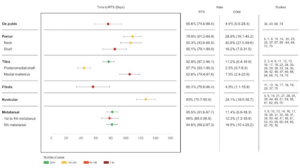In this blog post we summarise the key points of our systematic review about low- and high-risk bone stress injuries (BSIs). Our study (recently published in BJSM) was a collaboration between the University Medical Center Hamburg-Eppendorf, Harvard Medical School, U.S. Army Research Institute of Environmental Medicine, MSH Medical School Hamburg and Indiana University [1].
Why is this study important?
BSIs are commonly seen in athletes participating in sports associated with repetitive and cyclic bone loading. While many BSIs heal well with rates of return to sports being above 90%, some injury anatomical locations appear to be high-risk for treatment complications (e.g., bone nonunion). Given the clinical challenge of avoiding both under- and over-treatment in athletes, this study aims to provide further evidence on expected time for return to sport and treatment complications by anatomical location of BSI in order to help guide decision-making in athletes.
How was the study done?
A systematic literature review was performed. The study followed the updated PRISMA 2020 guidelines. PubMed, Web of Science, Cochrane CENTRAL, and Google Scholar databases were searched for studies reporting on return to sports after BSI. Both forward (“cited by”) and backward (citation) searches were conducted. Finally, 76 studies reporting 2,974 BSIs were included.
What did the study find?
We identified that the anatomical location of a BSI influences time and likelihood for return to sports. Timeline of a full return to sports ranged between five and 20 weeks for most anatomical locations of BSI. Femoral neck, anterior tibial shaft, and tarsal navicular BSIs were identified as being associated with an increased rate of treatment complications and a longer average time for return to sports. In contrast, pooled data identified BSIs at the posteromedial tibial shaft, femoral shaft and fibula as being associated with a low rate of treatment complications and the shortest average time for return to sports (see Figure).

Figure: Pooled data on time to return to sports (mean±SE), rate of return-to-sports (%, 95% CI) and treatment complication rate (%, 95% CI) are presented for the most commonly reported sites of bone stress injuries. Adapted from [1].
What are the key take-home points?
The anatomical location of BSI may influence time out of sports participation, rate of return to sport, and treatment complications. Clinical decision-making in athletes with BSI should account for anatomical location of injury.
References:
[1] Hoenig T, Eissele J, Strahl A, Popp KL, Stürznickel J, Ackerman KE, Hollander K, Warden SJ, Frosch KH, Tenforde AS, Rolvien T. Return to sport following low-risk and high-risk bone stress injuries: a systematic review and meta-analysis. Br J Sports Med. 2023 Jan 31:bjsports-2022-106328. doi: 10.1136/bjsports-2022-106328.
Twitter:
@hoenig_tim, @kristypopp, @drkateackerman, @k_hollander_, @StuartJWarden, @AdamTenfordeMD, @TimRolvien